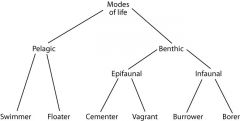![]()
![]()
![]()
Use LEFT and RIGHT arrow keys to navigate between flashcards;
Use UP and DOWN arrow keys to flip the card;
H to show hint;
A reads text to speech;
11 Cards in this Set
- Front
- Back
|
What are fossils? How old do fossils have to be? Which fossils are better preserved? |
Fossils are the preserved remains of traces of organisms from the past.
In order to be a fossil, specimen must be arbitrarily older than minimum age of 10,000 1. Hard parts are better preserved 2. Substrate also impacts likelihood of becoming a fossil 3. Sedentary, more likely than mobile |
|
|
What are the two different types of fossils Describe them and give examples |
Two main types of fossils:
1. Trace Fossils - impressions made on substrate, record past activities: Trails, Tracks, Burrows, Excrement 2. Body Fossils - record of actual organism or some part of it - most often it is the hard parts of the organism preserved: Shel, Bone,Teeth - rarely Skin, Muscle, Tendon are preserved |
|
|
How are Body Fossils preserved? Name the two ways Give Examples |
Two preservation methods 1. Direct preservation: material is preserved without any changes, aside from loss of soft tissue. Common in groups like corals and sponges 2. Indirect preservation - occurs when original organic material is partially to fully changed into new material, several ways: carbonization, petrifaction, as dissolution and replacement |
|
|
What is the carbonization preservation method? How is it done? Describe What groups is it common in? |
Carbonization - many fossils are preserved as thin films of carbon
Process 1. Material in question is buried 2. Chemical reaction --> water transforms organic material of plant or animal into thin film of carbon 3. Nitrogen, Hydrogen, and Oxygen are driven off as gases, leaving carbon outline of orginal organism This preservation is common in group suc as fish, insect and plants |
|
|
Describe the Petrifaction preservation method? Steps? What two groups is it found in? |
Petrifaction 1. Material in question is buried 2. Groundwater percolates through pore spaces in biological tissues 3. Solution that is supersaturated in calcium carbonate or silica precipitates minerals in pore spaces 4. New material fills up available pore spaces and fossil becomes solid rock, which is still partially composed of original material common in groups of plants and shells |
|
|
Describe the 3 steps in Dissolution and Replacement What groups is this preservation method common in? |
Dissolution and Replacement 1. Material is question is buried 2. Groundwater seeps through sediments and original material dissolves, leaving a void, which preserves the shape of the organism 3. Void is filled with sediments or another mineral, which precipitates in the void such as calcite In these cases, the preserved fossil often mimics original organism in amazing detail e.g. common in shells as well as in other groups such as trilobites |
|
|
Describe the two different situations of Dissolution and Replacement What does each situation form |
Dissolution and Replacement
Situation 1 When shell is buried, the inside of the shell that was originally filled with soft tissue does not get filled with sediment and remains empty In this case when the shell dissolves, the entire central cavity is empty. Subsequently, this space is infilled with either additional sediment or a mineral precipitate Impression of organism on surrounding rock will be preserved. External mold. Replica of original shell will be present, forming a Cast Situation 2 When shell is buried, inside of shell originally filled with soft tissue does get filled with sediment In this case, when original shell dissolved, only the space occupied by the shell is empty, and is subsequently infilled with either additional sediment or a mineral precipitate Similar to situation 1, external mold and cast will be preserved. Internal cavity of animal get filled with sediment. Impression of inside of shell is also preserved. Called internal mold |
|
|
What are the 2 major modes of life? |
Important to understand adaptations in fossil record Organisms with this lifestyle have maximum dispersal Benthic: includes organisms that live on or within the substrate Organism have limited disperal |
|
|
What are the two modes of Pelagic animals? |
Two different methods of functioning in Pelagic Organism 1. Nektonic groups can swim freely and are not dependent on currents - groups in this system can range from microscopic to many meters long 2. Planktonic groups which move through water column by floating or drifting - small or microscopic |
|
|
What are the Benthic modes of life Describe the two groups and two subgroups of each |
Benthic organisms
1. Epifaunal - live on the substrate 1A. Cementing lifestyle - often sessile meaning they do not move freely. - these animals tend to have radial symmetry or are asymmetric often cement to their neighbors or live in holes or cavities 1B. Vagrant lifestyle - organism move around substrate, usually bilaterally symmetrical and tend to have head 2. Infaunal - live within the substrate 2A. Burrowing lifestyle - burrow into substrate like sand or mud 2B. Boring lifestyle - organism bore down into hard substrate like rock. Can cause significant damage to hard substrates. Groups known as bioeroders |
|

Different marine evnironments |

Tree of modes of life
|

